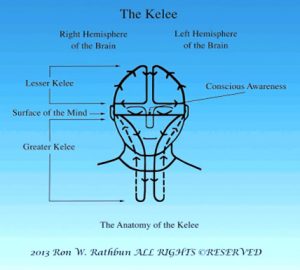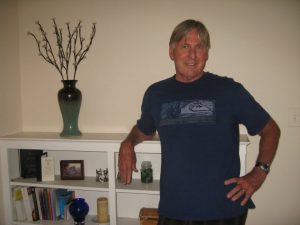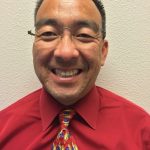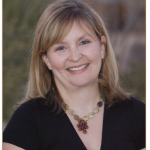What is Kelee® Medicine?
Kelee medicine is the ability to impart harmony of mind to the physical body to inspire healing.
Articles on Kelee Medicine:
- UCSD Physician Update:
How Kelee Meditation Can Help You Become a 5-Star Physician - Prevent Disease:
Kelee Meditation, Groundbreaking Research On The Mind and the Anatomy of the Kelee at UCSD - San Diego Union Tribune:
Meditation Makes Better Doctors - UCSD Journal of Nursing:
The Experience of Kelee Meditation: How It Impacts My Nursing Practice
 How Kelee Meditation Can Help You Become a 5-Star Physician
How Kelee Meditation Can Help You Become a 5-Star Physician
Dr. Daniel Lee and Dr. Amy Sitapati
Dr. Tom Savides, our chief experience officer, was curious about why several of the 5-star rated physicians at UC San Diego Health felt that Kelee Meditation had contributed to improved patient experience. We wanted to share a brief explanation, including how you might benefit from this type of practice.
What is Kelee Meditation?
Kelee Meditation is a unique 5-minute meditation done twice daily to develop stillness of mind. Stillness of mind can help reduce mental chatter and allow you to develop a relaxed, natural mindfulness, not a forced mindfulness which takes energy to maintain concentration.
How does Kelee Meditation improve communication?
In healthcare, we know that communication involves two people – you and your patient. We feel that being present for your patient is one of the single most important skills that you can have as a provider.
Kelee Meditation helps us pay attention to how we communicate, be openly receptive to what patients have to say and be receptive to patient choice, even when we may disagree with what our patients hope to share with us.
Tip #1: Kelee Meditation can help you learn and refine what someone says versus what they mean or how they really feel. For example, when a patient says, “I’m fine” but your perception is that they aren’t fine at all.
Tip #2: Kelee Meditation can help you be more present with patients and more receptive to what they say instead of thinking ahead about what you’ll type in your patient’s Epic note.
Tip #3: Kelee Meditation can help you remain open to what a patient has to say…even if you disagree with it. When we are rigid or closed off, our patients can perceive us as cold or uncaring, especially when our nonverbal cues change to discomfort and our voices raise to shoot down what they’d hoped to share with us.
Please stay tuned for a webinar on this topic.
 Kelee Meditation, Groundbreaking Research On The Mind the Anatomy of the Kelee at UCSD
Kelee Meditation, Groundbreaking Research On The Mind the Anatomy of the Kelee at UCSD
It is has long been known, in the world of medicine that emotional problems can manifest as physical ones. Emotional stress becomes distress to the nervous system and does not allow it to work properly. How does one decompress the stress that living in our modern society brings? What makes Kelee meditation different?

If you study how most forms of meditation work, you will see they are actually a concentration exercise, where the student focuses on an object, a mantra, or on their breathing. In Kelee meditation, the student learns to be still, in the place that precedes what they’re focusing upon. By learning to still the mind in a specific way, via the anatomy of Kelee, and by learning the basic principles of the Kelee, a new way of understanding meditation, and the mind can be learned. And so, what is the Kelee? The word Kelee (pronounced key-lee) is in ancient Sanskrit, Greek and Hebrew word, and means vessel or receptacle. The Kelee is the receptacle of one’s life experience. If one has not had any negative experiences in their life, their Kelee will be open. But who hasn’t had any negative experiences?
Have you ever been in a good state of mind and been triggered by someone into a bad mood? When you find yourself reacting in ways, that you don’t like, you are experiencing negative emotion from thought-form images, commonly referred to as issues or compartments. Compartments are negative emotional issues that become trapped within the Kelee.
And so, how does practicing Kelee meditation decompress negative emotion?
For anyone who has tried to quiet their thought activity, the first thing they will say is, “It’s not easy” and “How do you stop thinking about negativity and looping through it”?
When you learn the basic principles of the Kelee, you will see there is a distinctive difference between the brain, where thinking is, and the mind. When you access the deeper states of mind, you move away from the incessant brain chatter. When you understand the anatomy of the Kelee, you will learn to relax out of brain function, and be still, in mind function. It is from a still mind that you stop giving negative mental energy to compartments and feeding them. Compartments are not only a negative feeling mentally, but have a degenerative effect on the central nervous system, and every other system in the body. Once in your Kelee, they can pull energy from your immune system 24/7. When you give energy to negativity, you are robbing your physical body of vitality.
To heal the physical body one must start by cleaning up the negative condition of the Kelee. It is from learning to move out of the thinking process in the lesser Kelee, and relaxing into the greater Kelee, that detachment from thinking is achieved. This detachment from compartments starts the process of health and regeneration, soothing the nervous system into healing the physical body.
The founder of Kelee meditation is Ron W. Rathbun. He began practicing stillness of mind in 1975, at the age of 19, as a way to help himself feel at peace within, and with the outside world. Ron learned about the inner-workings of the Kelee, by carefully observing his thoughts and mind, after being still. People who knew Ron, saw how much calmer and non-reactive he was, and asked him to teach them, what he had learned about the Kelee.
Since those early years of teaching, how people have heard of KM, has been by word-of-mouth, or through his books. In 2005, Dr. Daniel Lee a physician at UCSD was referred to Ron. Dr. Lee was profoundly impacted by how practicing KM had helped him be a better physician and a better man. He also realized that KM could greatly help his patients. In 2013, Dr. Lee completed a five year medical study showing how practicing KM can significantly decrease one’s stress, anxiety and depression.

Professor says meditation makes better doctors
Ron W. Rathbun of Oceanside is the founder of the Kelee Foundation, which promotes a type of meditation that is being taught to UC San Diego medical students.(The Kelee Foundation.)
Some UC San Diego medical students have been studying an ancient but little-known form of meditation from a professor who believes the practice can make them better doctors. “If a physician is in a good mental space, the physician can take care of patients in a better way,” said Dr. Daniel Lee, a clinical professor of medicine who treats HIV patients at UC San Diego’s Owen Clinic.
Lee teaches Kelee meditation to first- and second-year medical students in the elective class Medicine 249, which started in the fall of 2015. It wasn’t easy getting approval from the internal review board, and Lee said he doesn’t know of any other university that teaches meditation to medical students. “There was resistance,” he said. “We submitted the recommendation for the class two or three years ago and had gotten turned down.” Lee said he originally wanted the class to be just about Kelee meditation, but at the school’s suggestion he redefined the course to be about how the practice can be applied to patient care. In putting the course together, Lee worked Ron W. Rathbun of Oceanside, founder of the Kelee Foundation and the mentor who taught him the practice about 10 years ago.
Rathbun describes Kelee meditation as a method of clearing the mind and dissolving negative thoughts. Unlike better known types of meditations that involve focusing on breathing or repeating a mantra, Kelee meditation involves focusing on nothing. “It’s the most difficult thing you can do in the mind,” Rathbun said. “The mind can only do two things. It can be in motion, and it can be still. Most of the time it wants to be in motion.” Mantras and breathing exercises also are techniques to still the mind, but Lee and Rathbun said doing either still requires the mind to be active. Rathbun admits that it sounds like an oxymoron, but the goal of Kelee meditation is an awareness of nothing. That awareness of nothing leads to the ability to dissolve negative thoughts that Rathbun said are compartmentalized in the mind, relieving stress, anxiety, depression and other distracting chatter that leaves people unfocused. While that can be hard to grasp and even harder to master, Rathbun said he’s seen students learn the skill quickly.
Lee said he began the practice 10 years ago following the breakup of a relationship. His partner had practiced Kelee meditation, and he said he decided to give it a try to deal with his own issues. Lee said that as he saw the practice work on him, he realized its potential for helping medical students who often deal with burnout and depression. On a larger scale, he also saw that the practice would someday make them better physicians.
 Dr. Daniel Lee of UC San Diego’s Owen Clinic teaches Kelee meditation, a practice he said can help his students in their studies and make them more attentive physicians.(Daniel Lee) “How many times have you gone to a physicians and they don’t seem present?” he said. “What happens in a patient-care setting if they’re stressed out? They can’t really provide good care for patients. Part of the goal is to help students be in a good space throughout their day so when they’re working with patients, they’re going to be present.” Lee said he believes all meditation works on some level, but offer only temporary solutions. The popular Transcendental meditation require 20 minute sessions twice a day, while he said Kelee meditation requires only five minutes twice a day because its effects are more lasting.
Dr. Daniel Lee of UC San Diego’s Owen Clinic teaches Kelee meditation, a practice he said can help his students in their studies and make them more attentive physicians.(Daniel Lee) “How many times have you gone to a physicians and they don’t seem present?” he said. “What happens in a patient-care setting if they’re stressed out? They can’t really provide good care for patients. Part of the goal is to help students be in a good space throughout their day so when they’re working with patients, they’re going to be present.” Lee said he believes all meditation works on some level, but offer only temporary solutions. The popular Transcendental meditation require 20 minute sessions twice a day, while he said Kelee meditation requires only five minutes twice a day because its effects are more lasting.
Rathbun said the technique goes back thousands of years, and the word “Kelee” is a Sanskrit word that refers to different states of mind. He called the practice deeply spiritual, but based in science. “The most important thing we’re trying to do is bring some understanding that there is a difference between brain function and mind function,” Rathbun said. “Brain function is basically associated with memorization. Mind function is associated with understanding, which means that you can read a book, but it doesn’t mean you’re going to understand it.” In a practical sense, Rathbun said the meditation can help med students tap into the greater resource of the mind and develop an understanding of how to treat patients rather than just remembering book lessons.
Lee said students are not graded on how they meditate, but rather evaluated on their personal descriptions of their experience doing Kelee medtiation. “From their answers, we can usually get a sense as to whether or not students are doing their practice and understanding the concepts or not,” he said.
Noelle Van Rysselberghe, 25, is a third-year UC San Diego medical student who took Lee’s meditation class last year to improve her ability “to be fully present in each moment.”
“When you recognize that your reactions are coming from a compartment within yourself, the compartment begins to lose power over you,” Rysselberghe wrote in an e-mail. “I have become less reactive and really do feel like I am more in the driver’s seat of my life than I used to be.” Rysselberghe wrote that after a few weeks of meditating, she found herself more calm and less likely to react to small things like spilling protein powder on the floor or finding her roommate hadn’t done the dishes.
On a larger scale, she also wrote meditating helped deal with her family after her mother was diagnosed with breast cancer. “I found learning the difference between compassion and empathy has helped me lift up others who are in a sad place instead of bringing my own mood down to join them at their sad place,” she wrote.
There’s a reason Kelee meditation isn’t well known or widely practiced. Rathbun said he learned it in 1978 from a retired Caltech professor and astrophysicist who held two doctorates and three master degrees.
“He knew more about the mind than anybody I ever met,” Rathbun said.
Rathbun holds and closely guards the trademark to Kelee meditation, and he teaches it in his Oceanside studio to a group that hasn’t had an opening in years. Outside of Lee’s classroom, a husband and wife team in Australia also teach it. “I knew early on I didn’t want somebody to take this and make money off it when they didn’t understand it,” Rathbun said. “Nobody can even use the name because I have it so protected. Not because I don’t want the world to have it. I don’t want to turn it into something that doesn’t work.”
By Gary Worth, July 31, 2016

 I have wanted to be a nurse my whole life, and today I am a certified pain management RN. I work in the Pain Procedure Clinic caring for people with chronic pain, and I can’t imagine doing anything else. My aspiration is to help people in their time of need…I know that I am doing my heart’s work, so why did it give me stomach pains, headaches, and tears instead of the joy I anticipated? It turns out it was because I was in my head and not in my heart. For years I moved through my workdays feeling anxious and stressed out. I was jealous, and maybe resentful, of the peace that other people seemed to achieve so effortlessly. I have always identified myself as an empathetic nurse, and I thought that was the way to best serve my patients. Empathy is the ability to put yourself in someone else’s shoes. Unfortunately, when I put myself in my patients’ shoes I only ended up feeling their pain and suffering, and then I could no longer be of any use to them.
I have wanted to be a nurse my whole life, and today I am a certified pain management RN. I work in the Pain Procedure Clinic caring for people with chronic pain, and I can’t imagine doing anything else. My aspiration is to help people in their time of need…I know that I am doing my heart’s work, so why did it give me stomach pains, headaches, and tears instead of the joy I anticipated? It turns out it was because I was in my head and not in my heart. For years I moved through my workdays feeling anxious and stressed out. I was jealous, and maybe resentful, of the peace that other people seemed to achieve so effortlessly. I have always identified myself as an empathetic nurse, and I thought that was the way to best serve my patients. Empathy is the ability to put yourself in someone else’s shoes. Unfortunately, when I put myself in my patients’ shoes I only ended up feeling their pain and suffering, and then I could no longer be of any use to them.
I thought about my patients day and night. Occasionally I would find time for myself to get a massage, pedicure or even a walk along the ocean, but I was still carrying a high level of stress. Kelee meditation has helped me to move from empathy to compassion, where I am drawing people in to my openheartedness by exhibiting harmony in my being.
I am very efficient at work. I have a great memory and can recall the mutually established goals that my patient and I had set at our previous appointment. That hasn’t changed. What has changed is that now I can separate myself from my patients so that I don’t take on their suffering as my own. The best way to care for my patients is to feel what is occurring as we communicate and to trust what I am sensing.
This isn’t my first attempt to find peace of mind in my work. I took the eight-week Mindfulness Based Stress Reduction (MBSR) Course in 2009. I enjoyed it and found it really beneficial. MBSR taught me to appreciate the present moment; to leave the past behind, and not try to anticipate or control the future. I practiced fairly consistently for the first three months; and then the busyness of life got in the way. MBSR requires 45 minutes to an hour daily, and little by little I practiced less often until I was back where I started. I still am mindful in my life- minus the long daily meditation. When I am out walking I see the sky and the clouds, I even can taste the air. I practice mindful eating, and I am generally more aware of the moment; but without the daily practice my work stress was no better than before. Clearly, I was on the right track. I just needed to find the best method for me.
In April 2013, I was privileged to take part in a study introducing Kelee® Meditation to UCSD nurses. It was ten weeks of learning and reflection, and I could feel myself getting lighter with each practice. With Kelee® Meditation I meditate for five minutes, and then I reflect and enter my thoughts in a journal twice daily. Kelee® Meditation is a practice where we focus our conscious awareness at the top of the head. Conscious awareness is our thoughts about external stimuli that are swirling around in our brain, but we can direct them inward. Then, we move the conscious awareness down until we reach the surface of the mind, allowing it to spread out and settle. The surface of the mind is the division between the lesser and greater Kelee®, between intellect and deeper states of mind and emotion. Lastly, we further drop down
Sarah C Babcock BSN, RN-BC graduated from University of Iowa in 1993. She has worked at UC San Diego Health System since 2000. She joined the UCSD Center for Pain Medicine in 2005. Sarah is ANCC certified in pain management, and is pursuing her holistic nursing certification. She has completed Healing Touch Levels 1 and 2 through Healing Touch International and is available to share her practice with you.
REFERENCE
R.W. Rathbun (2010). Troubleshooting the mind: Understanding the basic principles of the Kelee. Quiescence Publishing
You can begin the Kelee meditation practice today.
